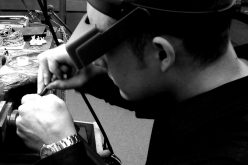BECCA MARTIN-BROWN
bmartin@nwaonline.com
“The work was hard and unfamiliar, and the water was not clean. Malaria from mosquitoes made us sick, and too many died. I heard their cries from the cotton field.” — Father Pietro Bandini
__
For much of the 20th century, Tontitown was often perceived as a wide spot in the road west toward the bright lights of Tulsa, Okla. Growing up in Fayetteville, Charlie Alison’s first impressions were the common ones in Northwest Arkansas.
“My introduction to Tontitown was in the 1960s or ’70s, going up to the Grape Festival with my family, eating spaghetti and taking a spin through the midway,” he says. “I vaguely understood then that it was an Italian enclave but didn’t learn the background of how the Italian families wound up in Arkansas until much later.

“That probably happened when I was a reporter at The Springdale News,” adds Alison, who is now executive editor for University Relations. “In addition to covering the Rodeo of the Ozarks, one of the rites of passage for a new reporter at the paper was covering the Tontitown Grape Festival and trying to find a story that no one else had told yet.”
Filmmaker Larry Foley has found that unique story — although pieces of it have been told for decades. His new documentary, “Cries From the Cotton Field,” tells the tale of an Italian priest and his quest to lead immigrants to a better life. Shot in southeast Arkansas around Lake Village; in Rome, northern Italy and Milan; and in the remaining grape vineyards of Tontitown, the film moves back and forth between the past and the present, with eyes to the future.
During the Northwest Arkansas filming, Alison portrayed Father Pietro Bandini, who led about 40 families from a failed experiment called Sunnyside to a place that felt a lot more like home.
“There is an odd transition that occurs in the brain when I’ve tried to portray a real person, and it happened here, too,” Alison says. “At first, it feels completely phony, like I could never be the person I’m trying to portray. But in looking at photographs of Bandini, you get a sense of the person, what he cared about, what he wanted for the Italian immigrants …

“With Bandini, it didn’t feel like I really connected with him until we were filming out in a vineyard on the west side of Tontitown, and I understood what the grapes would mean to him and to his followers.”
The story of the Tontitown Italian immigrants starts at the end of the American Civil War, when African American slaves were freed, says Foley, a University of Arkansas professor in the School of Journalism and Strategic Media. Southern plantation owners had a problem — how to harvest cotton when they no longer had an unpaid workforce. Recruiting Italians to come to the Sunnyside Plantation in southeast Arkansas “was a scheme by a robber baron, Austin Corbin, from the northeast, who bought the plantation for practically nothing, after Reconstruction.”
He of course needed laborers. And Prince Ruspoli, the mayor of Rome, worked with Corbin to recruit families from northern Italy — who, Foley says, were “lighter skinned” and would fit in because they “look[ed] like Southern white folk.”
What the immigrants — who believed in the United States as the land of inestimable opportunity — didn’t expect was a ship passage so rough people died before ever reaching America and a brave new world that Foley describes as “Hot. Unhealthy. They drank unfiltered swamp water. Mosquitoes were as big as bumblebees. Malaria was a real problem. There were more deaths than births. As one descendant said, ‘It was a terrible affair.’

“By 1897, it was obvious the Sunnyside experiment was a bust,” Foley says. “People were dying. The Italians were being cheated. They wanted out, and their priest led the way.
“The climate in Tontitown was much more like where they originated, northern Italy,” Foley says of the relocation. “They knew how to grow grapes, so that’s what they did. And they became successful at it.
“There were some locals who were initially resistant to Italian Catholics moving in, but over time, that ‘fear’ of ‘who are these people,’ went away. It’s fun to see how many descendants of those original settlers still live in the area,” he muses. “They’ve been around since Father Bandini brought them here in the winter of 1898, and many still live in and around Tontitown.”
Foley talked to those descendants, but he also went to Lake Village and talked to people whose family history includes the life of great hardship on the Sunnyside Plantation.
“They weren’t slaves, but they were tricked into becoming sharecroppers, which was a brutal existence,” Foley says. “They did not own their own land, and they were forced to sell their crops for shamefully low prices to the company store. They were paid with ‘Sunnyside money,’ which was useless anyplace except the plantation.
“As historian Dr. Calvin White says in the film, ‘Slavery was illegal, but peonage was not.’”
Ed Eaves, director of photography in Italy and editor of the film, talks about one of the documentary’s biggest challenges — “all traces of Sunnyside Plantation have been erased.”
“The 1927 Mississippi River flood took much of it,” he says. “Even the railroad tracks that serviced the plantation were later taken up to be able to plant more cotton. Lake Chicot, the river and the land are all that remain. Using the original plat map of Sunnyside Plantation and [U.S.] Director of Photography Trey Marley’s outstanding drone footage, we were able to capture the scale and beauty of this unique landscape.
“Traveling to the small village of Valli del Pasubio in northern Italy was certainly a highlight,” Eaves adds. “Shooting in the very church that in 1895 sent the first immigrants on their journey to America was a special moment. Experiencing the incredible highland countryside and lush valleys in the shadow of the Dolomite Mountains really brought home for me the shock the settlers must have felt when they realized just how different an environment the Mississippi River Delta was to their homeland. It must have been quite a shock.”
Foley and Eaves both have long lists of people who made the film possible — Libby Borgognoni and her son Anthony Borgognoni, descendants of the Sunnyside immigrants; Emily Pianalto-Beshears, director of the Tontitown Historical Museum, “extremely helpful providing photographs, artifacts and access”; Jim Greeson, composer of original music for the film; fundraiser Susan Foley; and several of Foley’s students who served as production assistants.
“Foley often says filmmaking is a team sport,” Eaves says. “Telling a complex story without a written narrative thread but instead using only interviews and contemporaneous writings is a challenge. … We had a great team of professionals on this production.”
“We’ve been working on this film for more than two years, and we can’t wait for you to see it,” Foley says. “It’s an epic tale of faith, heartbreak, and resilience. And it has the added benefit of being true!
“Bandini is a heroic character,” the filmmaker concludes. “Flawed, at times headstrong, but he is regarded today, as he was long ago, as a Moses figure by the Italian descendants of Tontitown. I loved telling his story, using Bandini’s own words. It’s a character-driven film, and Bandini is a real character. He’s become a personal hero.”
__
FAQ
World Premiere:
‘Cries From The Cotton Field’
WHEN — 6 p.m. May 8
WHERE — Marsha Jones Performing Arts Center at Har-Ber High School in Springdale
COST — Free
INFO — https://news.uark.edu/articles/70289/world-premiere-of-cries-from-the-cotton-field-slated-for-may-8
FYI — There will also be a screening May 28 at Butterfield Trail Village in Fayetteville. Email Riki Stamps for information at rstamps@btvillage.org.










